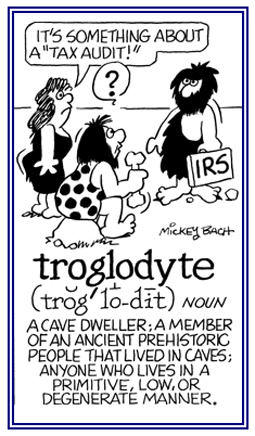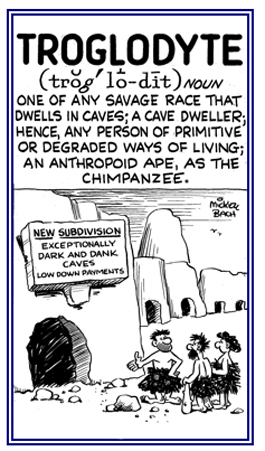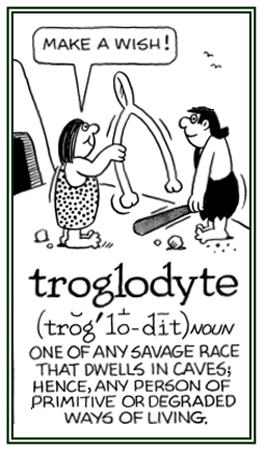troglo-, trogl-
(Greek > Latin: cave; thriving in caves; cave dweller)
The Greek troglo- also means, "one who creeps into holes" and "a hole formed by gnawing".
2. Etymology: the genus name (Greek troglodytai, from trogle, "a hole" (properly "a hole formed by gnawing" and dyein, "to enter") refers to the tendency of these wrens to enter small crevices and similar areas as they look for food.
The Troglichthys rose, like other fish in grottos, has a row of pressure sensors along each side of its body which enables it to detect other animals several yards away.
2. An animal living entirely in the dark parts of caves: Many troglobionts have adapted to life in caverns and no longer have functional eyes; in other words, they are blind.
In subterranean streams and pools, troglobiotic fish and salamanders sense vibrations in the water.
Here is some additional information about troglobites.
2. Descriptive of an animal living entirely in the dark parts of underground dwellings: Most troglobitic creatures have become specifically adapted for life in total darkness and over time they have evolved to develop improved senses of smell, taste, and vibration detection, while losing anatomical features that are unnecessary without light; such as, eyes and pigmentation.
Many troglocoline species include certain species of fish, crayfish, and flatworms; however, most of them have a ghost-like pallor or unnatural paleness on their outer surfaces and cannot see and some don't even have any eyes.
The troglocoline animals are born, reproduce, and die without ever leaving their caves; unless they are accidentally carried out.
2. A person living in seclusion or someone who is considered to be reclusive, reactionary, and out of date: Usually a troglodyte is someone who is unacquainted with what is going on in the rest of the world.
Some computer programmers are thought of as being troglodytes because they work alone with their machines and have little contact with other people.
The term troglodyte doesn't necessarily apply just to prehistoric cave dwellers. It also describes someone who lives in a dingy domicile or people who are so socially inept or culturally deprived that they seem to have just emerged from a subterranean cavity into the "blinding light of civilization" or those whose thinking or behavior is considered to be uncivilized and backward.
3. Creatures that live underground: Moles, worms, ants, etc. are considered to be troglodytes because they exist in the terra firma or soil.4. Etymology: from Greek trogle, "hole" + dyein, "get into".



Go to this Word A Day Revisited Index
so you can see more of Mickey Bach's cartoons.
2. A descriptive term for anyone who lives in seclusion or solitude (alone): When he was existing alone, Simon had a very troglodytic lifestyle in that he was avoiding contact with anyone else.
All troglodytical hermits who live in underground dens are considered to be primitive in character, coarse, brutal, or degraded in the way they look, live, or behave.
Related "cave, cavern" word sources: cav-, cavern; speleo-; spelunc-, spelunk-; stalac-, stalag-.

